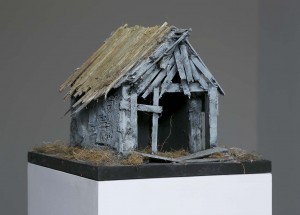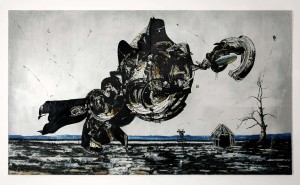Predator: Chris Hawtin curated by Juan Bolivar
The Predator society builds sophisticated spaceships, yet they should not look as sleek and hi-tech as a Star Wars stormtrooper. They are a tribal culture, yet their look should not be as primitive as the orcs from Lord of the Rings. They are also a warrior culture, so the ornate cannot conflict with the practical.
Alec Gillis (AVP: Alien v.s Predator, 2004) discussing the Predator design.
In the 17th century a group of northern European painters, principally Dutch, travelled toItalyadopting upon their return the style of landscape painting that they found there at the time. Artists such as Jan Both (1615-1652) and Nicolaes Berchem (1620-1683) brought back with them visions of mountains and peasants basking under golden skies, incorporating Italian models and motifs into their own work. Often among Classical ruins, their light-filled canvases of exotic lands were in contrast with the flat and cloudy scenes ofHolland, presenting a curious hybrid hyper-reality. Later, artists such as Aelbert Cuyp (1620-1691) and Philips Wouwermans (1619-1668) were inspired by these works to create their own interpretations of landscapes they had never seen.
Image: Chris Hawtin: Welcome to OUR Systems, 2012. 190cm x 300 cm
A similar dislocated encounter with places elsewhere is offered in the paintings of Chris Hawtin. In these works of fictional universes and narratives conjured by the artist, Hawtin questions the human relationship to landscape in our current hyper-digital technological era, and how our relationship to the concept of landscape has become fictionalised through the proliferation of global media, cinema and virtual environments.
Like in the 1987 film ‘Predator’, where a creature from another place (or time), hunts down a group of US Special Forces mercenaries in the jungle, Dredger (The Part of No Part), 2012, presents a bio-morphic figure set against a barren desolate land. Frozen in motion – possibly assessing its territory – the exoskeletal figure seems to reflect the landscape around it, creating a synergetic relationship between this hybrid being and the land it is alien to, yet appears to physically own. In Welcome to OUR Systems, 2012, we are reminded of these figures ‘foreignness’ as a similar creature scans an earth-like planet from outer-space.
In Predator: New Works by Chris Hawtin, fictionalised characters are brought together in a set of integrated relationships. The pencil drawing Jerome – The Hermit presents the character as a war-like trophy, butJerome’s Hut suggests this character to be a hunter as much as the hunted. The latter is a small architectural model where an ambiguity between prey and predator is implied. It also provides other clues for the processes involved in the making of these works; where figures are created by the artist utilising architectural rendering programmes which are then projected onto the fictionalised settings of these paintings. Like the DutchItalianates, Hawtin builds a world of composite motifs appropriated from different places and times.
Highlighting the interface between new and old technologies at play, for this exhibition Hawtin, in collaboration with musician/producer Andrew Clemson, have together created an audio work made by taking a digital scan of an image of one of his paintings and transferring this image into a sine wave, which is then stretched, warped and manipulated to produce a 7 minute 24 second audio work Jerome (Ceramics). The audio work provides an eerie backdrop to the exhibition, exploring the simultaneous relationships in these works – much like the atmospheric soundtrack in the movie ‘Predator’ – where this creature blends and camouflages within the landscape, becoming one.
As if life imitated art, the General Atomics MQ-1 Predator is an unmanned aerial vehicle (UAV) used primarily by the United States Air Force (USAF) and Central Intelligence Agency (CIA) in combat over Afghanistan, Pakistan, Bosnia, Serbia, Iraq, Yemen, Libya, and Somalia. The unmanned drone vehicle, initially conceived in the early 1990s for reconnaissance and observation, has now been modified to carry and fire two AGM-114 Hellfire missiles and other ammunition. Cloud-like, camouflaging itself in the sky, it reminds us how frontiers are destroyed and created in this new era of hybrid technosystems.
________________________________________
Chris Hawtin. Born Ely, UK, 1974. BA Hons Fine Art (Painting) ChelseaCollegeof Art and Design 1999. Recent Exhibitions include: The Unity Engine and Other Stories (Artlounge Lisbon, Lisbon), 2012, Forbidden Planet(Jacob’s Island, London), 2012, Chris Hawtin and MilesThurlow (Malgras/Naudet, Manchester), 2011, Project PIGS Case (Supermarket Art Fair, Stockholm and Studio SKOUZE3, Athens), 2011, Polar Union (Denman Arts,London), 2010.
Publications: art.es magazine issue 44, Chris Hawtin, Work and Word, April 2011. David Ryan,Transitions/Abstractions,www.david-ryan.co.uk/transitions-abstractions.html.
Predator: New Works by Chris Hawtin is the second of three exhibitions curated by Juan Bolivar for Canvas and Cream Project Space, presenting debut solo exhibitions by unrepresentedLondon based artists.


